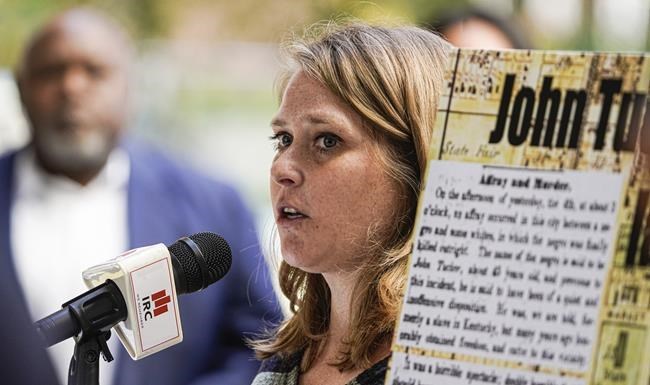
Historian and editor of the Indiana Historical Blog from the Indiana Historical Bureau, Nicole Poletika, speaks during the unveiling of an official state marker for John Tucker, a Black man beaten to death on July 4, 1845 at the intersection of Illinois and Washington Streets in Indianapolis, on Saturday, Sept. 30, 2023. Tucker, a freedman from Kentucky and father of two, was attacked after leaving a Fourth of July celebration while walking along Washington Street, and beaten to death by three white men while a crowd looked on. One attacker served three years while the other two served no time. (Michelle Pemberton/The Indianapolis Star via AP)
Republished October 02, 2023 - 11:13 AM
Original Publication Date October 02, 2023 - 10:11 AM
INDIANAPOLIS (AP) — The story of a Black man beaten to death in Indianapolis in a racist 1845 lynching is now part of the city’s cultural trail in the form of a historical marker.
The marker describing John Tucker’s slaying was unveiled Saturday by state and local leaders and members of the Indiana Remembrance Coalition, The Indianapolis Star reported. It was placed along downtown Indianapolis’ cultural trail close to where Tucker was killed nearly 180 years ago.
“Uncovering and documenting uncomfortable history is an obligation that we all must share. We must always seek to tell the full story of our history," Eunice Trotter, director of Indiana Landmark’s Black Heritage Preservation Program, said at the unveiling.
Tucker was born into slavery in Kentucky around 1800 and later obtained his freedom. He moved to Indianapolis in the mid-1830s and was a father to a boy and a girl.
On July 4, 1845, Tucker was assaulted by a white laborer, Nicholas Wood, as Tucker walked along Washington Street. He defended himself while retreating up Illinois Street, after which Wood and two other white men beat Tucker to death. A crowd gathered to watch.
Wood was later convicted of manslaughter, “a rarity in an era when Black Hoosiers could not testify in court,” the marker reads. The other men involved in his beating death served no time.
Tucker’s lynching forced his children into a legal battle over his property and perpetuated generational trauma for the family he left behind, said Nicole Poletika, a historian and editor of Indiana History Blog.
While often associated with hangings, the term lynching actually is broader and means “to put to death (as by hanging) by mob action without legal approval or permission,” according to Merriam-Webster.
Lynchings in Indiana from the mid-1800s to 1930 “intentionally terrorized Black communities and enforced the notion of white supremacy,” the historical marker states. Trotter said lynchings were not uncommon and happened in communities across the state.
“Having the knowledge of such instances forces us to confront some of the most harmful, painful layers of the African American experience in Indiana,” she said. “Acknowledging them is an important part of the process of healing and reconciliating and saying that Black lives matter.”
News from © The Associated Press, 2023